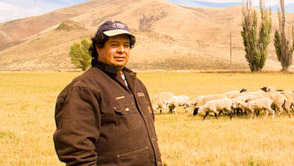The Heroes are the Herders
By: Amos S. Eno
Posted on:10/13/2011 Updated:03/23/2012The duty of all staff at Lava Lakes Ranch is to leave the landscape in better condition than they found it.
This is part of our Lava Lake series. Brian and Kathleen Bean’s family-owned ranch is located just southeast of Sun Valley where the Pioneer Mountains meet the Snake River Plain. They own 24,000 acres and control 900,000 acres of grazing allotment lands. Posts continue Tues/Thurs through October 2011.
“The heroes in this story are our herders," explains Brian Bean. "They actually do the management on the ground, and they are what differentiates Lava Lake from other operations. Our sheep foreman, Pedro Loyola, understands that protecting the  biological health of our grazing allotments is as important as raising fat lambs, and he implements the annual operating instructions we receive from the Forest Service and Bureau of Land Management with those goals in mind. He observes ecological conditions throughout the season and directs the herders accordingly.”
biological health of our grazing allotments is as important as raising fat lambs, and he implements the annual operating instructions we receive from the Forest Service and Bureau of Land Management with those goals in mind. He observes ecological conditions throughout the season and directs the herders accordingly.”
Some of their Peruvian herders, hired through the Western Range Association, have been working for Lava Lake and its predecessor ranches for more than 20 years. Every three years, the herders return to their communities in Lima or in rural villages at elevations as high as 14,000 feet.
“These are very thoughtful sheep herders and humane animal husbands - essential for our operations. Herders are compensated with a basic salary dictated by requirements for H2A visa holders. But we pay more because we bonus them in a way that reflects two things: how fat the lambs come off the mountain and how good they leave the range ecologically. If they get fat lambs, but violate our grazing instructions, the bonus goes away. It took about two years of education and training to get the system right. Our herders are truly our partners in conservation.”
It Takes a Community to Protect a Landscape
Everyone at Lava Lake believes that it’s their responsibility to leave the landscape in better condition than they found it. “We care about sage grouse and sagebrush too,” Brian says, “We do a lot specifically to benefit them. We put an easement over 2000 acres of prime habitat with assistance from the Farm and Ranchland Protection Program of the Natural Resources Conservation Service (NRCS) as part of their Sage Grouse Initiative. In our ten years of ownership, we’ve seen sage grouse here every year.
“I cannot say enough about NRCS; they’ve been steadfast in their support, helping us through complicated easements. The Nature Conservancy is also due great credit as holder of our first 7500-acre easement. We are now at nearly 12,000 acres under easement.”
The roughly 500,000-acre region that connects the Pioneer Mountains to the deserts of the Snake River Plain includes about 100,000 acres of private land, much of it sizable ranches. Lava Lake’s neighbor, the historic Flat Top Ranch, has also done a series of easements. A landscape which had zero acres of protected private land 10 years ago, now boasts well over 20,000 acres permanently protected.
“Our focus on landscape and ecoregional connectivity extends from local grassroots initiatives like the Pioneers Alliance, which assists local people in protecting their own lands, to a vision for public lands. It may not be done in my lifetime," Brian muses, "but we’re off to a fantastic start on permanently conserving the ecosystems of this region. We hope the other larger ranches that have started to work with Pioneers Alliance will continue their efforts to protect the integrity of the landscape.”
Return next week to learn how Lava Lakes Ranch is co-existing with wolves.
The entire Lava Lake Series:Making Working Wildlands Work for Conservation
 Sign In
Sign In
 Sign In
Sign In
